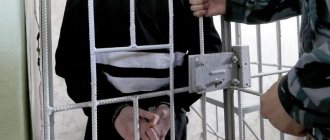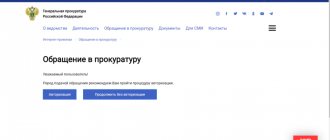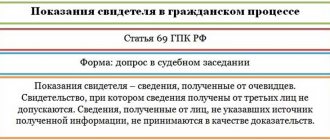How to apply for parole
There are two ways to apply for parole:
- The petition is submitted by the convicted person independently, through the administration of the correctional institution.
- The petition is submitted by the convicted person’s lawyer directly to the court.
The institution itself can also apply for parole, but this happens rarely; we will not even dwell on this option for now.
According to statistics, the vast majority of applications for parole are filed by convicted persons. through the administration of the institution - written independently.
Filing an application for parole through a lawyer costs, on average, 35 thousand rubles, a little cheaper in the regions, more expensive in the capitals. However, it cannot be said that having a lawyer improves the chances of release.
But it to correctly draw up an application for parole . The samples that hang on stands in colonies are long outdated and do not take into account either the latest changes in legislation or actual judicial practice on parole.
Receiving a refusal
Don’t be afraid to be eloquent in court, when considering your petition, describe all your positive qualities and you can even embellish them a little, since the judge is an ordinary person who is not alien to such concepts as philanthropy, kindness, children, etc.
There have been cases when judges granted a request for parole, even despite a negative characterization from the administration of the penal colony. There are no specific statutory grounds for refusal
in accepting the application.
In each specific case, the court is guided by the materials of the prisoner’s case at its disposal. Often the grounds for refusal
are the following:
- deliberate concealment of income and property by the convicted person in order to evade compensation to the injured party for the harm caused;
- reluctance of the convicted person to engage in labor activities in the institution;
- violation of discipline;
- lack of remorse and admission of guilt;
- negative position of the injured party.
Sample application for parole
As we mentioned above, most convicts prepare a petition on their own. As a rule, when preparing it, either a sample application for parole hanging on a stand in the detachment or the experience of fellow sufferers is used.
It is no secret that in most colonies there are no problems with mobile communications. Those convicts to whom it is available also find samples on the Internet. Less often, relatives send the application form by letter.
In fact, the correct sample application for parole from a convicted person is half the battle. Due to the heavy workload, judges are practically deprived of the opportunity to familiarize themselves in detail with all the submitted materials. At the same time, they read the petition itself quite carefully and a lot can really depend on how carefully and competently it is drawn up.
In addition, we have recently noticed another trend. Beginning in the fall of 2022, courts will be required to make audio recordings of all hearings on parole and the NBM. The judge is obliged to read the petition of the convicted person out loud, and since the text is therefore completely included in the protocol, he is forced to transfer it to the decision.
Even if the court refuses to satisfy the petition, the correct sample and impeccable form of the petition will help prepare material for the appeal. It will be much easier to challenge a rejected decision of the district court in a second instance, and, if necessary, in a cassation instance. Let us remind you that from October 1, 2022, the principle of complete cassation applies, i.e. courts are obliged to consider all cassation appeals. Thus, one application for parole can be heard in three courts at once.
Pardon concept
A pardon is a decision by the head of state to cancel a sentence or mitigate the punishment in relation to a specific convicted person. However, at the same time, it should be noted that such penalties as payment of material and moral compensation, or deprivation of awards, positions, or confiscation of property do not have retroactive effect. In fact, pardon is applied only in the context of releasing a convicted person before the deadline.
It goes without saying that the President is not able to consider every petition, therefore, before the paper comes to him for consideration, it must go through several authorities:
- The administration of the penitentiary institution in which the convicted person is serving his sentence. , to which the above-mentioned penitentiary institution is subordinate.
- A special commission that considers appeals from citizens regarding the pardon of convicted persons.
- The head of the local administration, which will forward the appeal to the President.
And only after this the mother’s petition will be submitted to the President of the Russian Federation for consideration.
See also: Standard Child Tax Credit in 2022
Application for parole - features of document preparation
The key feature is that the convicted person’s request for parole in court competes with the characterization provided by the institution. Sometimes squad leaders write very good and detailed characteristics that give the judge a complete picture of the person’s correction. Others treat their work formally, their characteristics are poor and contain only universal phrases, more like a template that is only formally adjusted to each convict.
There are also frequent cases when an institution deliberately prepares a bad, low-quality or incomplete reference for a convict - someone has annoyed the detachment, someone is needed by the institution (for example, he works well or is a reliable knocker). In such cases, it is the petition that should become the main source of truthful information for the judge.
If the data in the petition and the characterization do not match, the judge must definitely figure out at the court hearing why the discrepancy occurs. He will interview a representative of the colony and the convict himself, and figure out which of them is right and who is lying. If unresolved issues arise, the judge has the right to request additional documents.
In fact, a petition for parole is the only tool with which the convict himself can resist the position of the institution, which does not always support parole or the replacement of punishment with a more lenient one, and sometimes deliberately puts a spoke in the wheels of justice and the rule of law.
Application form
Actually, a petition is a form of a convicted person applying to the court with a request for parole (as well as for replacing the unserved part of the sentence with a more lenient type). Both of these petitions are submitted in writing, in accordance with Article 399 of the Code of Criminal Procedure of the Russian Federation.
When asking about the form of the petition, many convicts have in mind the appearance. An application for parole must be submitted in writing; it can be handwritten or typed on a typewriter or computer. If a person is in prison,
Contrary to the opinion of many FSIN employees, there is no ban on convicts submitting documents printed on a computer or typewriter. Documents for submission can be submitted by relatives or a lawyer; this is not prohibited by the Internal Regulations.
However, sometimes it is worth listening to the recommendation of the squad leader to submit a handwritten version of the petition. Here it is important to be able to distinguish good advice (based on the practice of a particular court or even a particular judge) from the tyranny of a detachment officer who believes that convicts should suffer.
The application for parole is usually submitted in two copies. One remains in his personal file, the second goes to court. The institution is obliged to transfer the petition of the convicted person to the court office within ten days from the date of filing, therefore, in many institutions, convicted persons are prohibited from putting a date on the petition until a special order from the head of the detachment. This requirement is completely illegal and significantly increases the time for consideration of the application.
A question of practice
Before the institution of pardon was introduced on the territory of the Russian Federation, and this is 2001, the number of convicts who were released from penitentiary institutions ahead of the deadline for pardon was more than 8,000. It goes without saying that among them were criminals who were in prison colonies for serious offenses - murderers, repeat offenders, and so on.
From the moment the procedure became regulated, the number of pardoned convicts was reduced to a minimum. Thus, in 2014, a positive decision was made regarding only 4 petitions.
Structure of the application
The structure of an application for parole is completely simple and logical. And this is exactly what you can see in the parole application template hanging in the detachment (the structure there is correct, but the content is often lame).
Petition header
In the upper right half of the sheet a so-called “header” is written, in which you need to indicate:
- Name of the court (applications for parole are considered by the district court at the place where the sentence is served). As a rule, petitions are submitted to the chairman of the court.
- Citizenship of the applicant (convict). This is how it is written: “from a citizen of the Russian Federation”, “from a citizen of Azerbaijan” and so on.
- Last name, first name and patronymic of the convicted person.
- Date of Birth.
- The name of the court that passed the sentence for which the convicted person is serving time.
- Articles under which he was convicted.
- Term of imprisonment.
- The name of the institution where the convicted person is currently serving his sentence.
Team leaders often require the start and end dates of the term to be indicated in the header. We recommend writing them in the application itself, and not overloading the header with this information.
Title of the application for parole
The title is very simple. Exactly in the middle of the line you need to write the word “Petition”. It can also be written in capital letters – “PETITION”. A line below, also in the middle - “on parole from serving a sentence.”
It should look something like this:
Petition for parole from serving a sentence
Body of the petition (main part)
Now the most responsible and important thing is the “body” or the main part of the application for parole. We recommend not only following this petition structure, but also writing in this order. Here's what you need to write about:
- A paragraph about by whom, when and for what a person was convicted, what punishment was assigned to him, where he is serving it.
- Reference points: date of arrest and taking into custody, sentencing and its entry into legal force.
- Data on attempts to challenge the verdict (appeals and cassation, appeals to higher courts) - with dates.
- Data on preventive measures, terms of detention in a pre-trial detention center, conditions and results of recalculation of the period of detention (if there was a recalculation).
- Data on arrival at the place of serving the sentence - date and method of arrival (convoy, independent arrival).
- Information about the part of the sentence served. It is imperative to indicate that the service provided for in Art. 79 of the Criminal Code of the Russian Federation part of the term - its departure is a formal basis for parole.
- A block of information about behavior, work and study, relations with the administration of the institution and other prisoners, support for connections with family and friends, and so on.
- Block of information about incentives and penalties.
- A block of information about employment in the colony and employment prospects after parole.
- A block of information about compensation for harm - for those who have a claim.
- Socially significant prerequisites for parole (young children, unemployed wives, sick parents, and so on - everything that can prove to the judge that you are more needed in freedom).
- Declaration (a statement about why the convicted person believes that he does not need to further serve his sentence and is worthy of parole.
Grounds for filing an application
When the main part of the petition is ready, you need to point out the laws under which the petition is being filed. We recommend writing it like this:
Some particularly zealous human rights activists recommend including the following in the list of grounds:
- Articles 2, 21, 29, 41, 45, 50, 55, 56 of the Constitution of the Russian Federation;
- Articles 3, 5, 6, 7, 13, 14 of the European Convention for the Protection of Human Rights and Fundamental Freedoms;
- Resolution of the Plenum of the Armed Forces of the Russian Federation dated April 21, 2009 No. 8 “On the judicial practice of parole from serving a sentence, replacing the unserved part of the sentence with a more lenient type of punishment”;
- Resolution of the Plenum of the Supreme Court of the Russian Federation No. 21 of June 27, 2013 “On the application by courts of general jurisdiction of the Convention for the Protection of Human Rights and Fundamental Freedoms of November 4, 1950 and the Protocols thereto”;
- Resolution of the Plenum of the Supreme Court of the Russian Federation dated December 20, 2011 N 21 “On the practice of application by courts of legislation on the execution of sentences”;
- a number of other laws and regulations.
This seems excessive to us (at least for the first application for parole).
The essence of the petition is the “petition” itself
Actually, it is this part that is the petition - what the convicted person petitions for, the court asks for. We see the meaning in two points:
- Release me from serving the remainder of my sentence on parole.
- Ensure my personal participation in the court hearing (if the convicted person does not want to participate in the trial, you need to write “consider the petition in my absence”).
In addition, recently we have included a third point in petitions:
3. Assist me in obtaining all the documents that are missing to make a decision on my parole.
Signature on the petition
Signing the petition would seem to be the simplest thing. However, this is what is often forgotten. Without a signature, the court may refuse to accept the application for parole or ZNBM. Of course, in this case it’s easy to sign the papers and submit again (you don’t need to wait six months for this), but time will be lost. So we say it loudly again:
DON'T FORGET TO SIGN YOUR PAROL APPLICATION!
The signature is usually placed approximately in the middle of the line, three lines are indented before it, and the first initial (the first letter of the name) and the surname are written in the line below, on the right.
If the application is printed on a printer or typewriter, and not written by hand, we recommend that you write your full name, patronymic and last name in full in the line before your autograph. This is not required, but is considered correct from a writing etiquette standpoint. Perhaps the judge will appreciate your gesture as a sign of respect for the court.
Release procedure
If the petition is granted, a copy of the decision is sent to the following authorities:
- The most condemned.
- To a penitentiary institution where a prisoner is serving his sentence.
- To the criminal inspection, which monitors the work of the above-mentioned penitentiary institution.
- To the administration of the city where the penitentiary institution is located.
Further, according to the internal regulations of the colony or prison, after completing all the necessary documents, the convict is released.
How to order an application for parole
As you can see, drawing up an application for parole is not as simple as it might seem at first glance. There are many little details and nuances that rarely fall into patterns; there is judicial practice in a particular court, which would also be good to take into account.
The importance that the court will attach to the merits and demerits of the convicted person may depend on how to draw up the petition. Some things can be further highlighted, while others, on the contrary, can be carefully formulated and buried a little.
The parole application template hanging on the stand in the detachment allows you to draw up the document correctly, but it will not reveal any nuances.
Lawyers charge from 15 to 200 thousand rubles for participation in a parole case, and on average - about 35-40 thousand. At the same time, the participation of a lawyer in the court itself brings practically no benefit.
ZNBM.ru service offers a compromise option. We will competently draw up an application for parole for you to submit independently through the colony.
The cost of a completed application is only 2,490 rubles.
Here's how it works:
- Contact us (form in the right column of the site);
- Send us the necessary data in any convenient way.
- Our team analyzes the practice of the relevant parole court over the past year.
- A professional lawyer will draft your application for parole.
- You receive the application in any convenient way.
- Copy the petition by hand in two copies.
- You submit an application through the head of the detachment or the special accounting department of the institution.
MOREOVER! We provide a guarantee for our work! If the application for parole ordered from us “does not work”, we will prepare an appeal completely free of charge against the court’s decision to deny parole.
Moreover, we can inexpensively file a petition through a lawyer, and in any region of the country. This proposal will certainly be appreciated by those who do not have to count on the support of the FSIN institution.
What to do if you are denied parole
According to statistics, Russian courts deny parole in almost half of the cases. Moreover, most refusals contain signs of violations of the law - either the criminal code or the criminal procedure code. We write custom applications in such a way that a possible refusal is easier to challenge. To do this, we work very closely with the practice of refusing parole.
Actually, if parole is denied, you can do the following:
- File an appeal to a higher court. Our appeals mostly work – the refusal is overturned, and less often the case is returned for review. If the city court also refuses, we will challenge it further, right up to the Constitutional Court.
- Draw up and submit a petition to replace the unserved part of the sentence with a more lenient type of punishment (MLB) - under Article 80 of the Criminal Code of the Russian Federation. The mechanism is approximately the same. It is necessary to carefully study the refusal of parole and work around the subtle points in the new application. You can apply for “eighty” immediately - this right is in no way connected with parole.
- Of course, it is necessary to apply for parole again after a refusal - the convicted person has the right to do this 6 months after the decision on refusal. However, we hope that in six months we will get you out anyway.
If you are denied parole, send us a resolution - it will help us prepare applications even better and help people even more effectively. In addition, you can order an appeal against a refusal of parole from us. For those who are denied our application, we file an appeal free of charge!
The legislative framework
A mother’s petition for clemency, as well as other types of mitigation of punishment, are regulated by the following legal acts:
- Article 50,71 and 89 of the Constitution of the Russian Federation.
- Article 85 of the Criminal Code of the Russian Federation.
- Article 176 of the Criminal Executive Code of the Russian Federation.
- Regulations on the procedure for considering applications for pardon.
- Decree of the President of the Russian Federation “On commissions on pardons in the territories of constituent entities of the Russian Federation.”
In general, there are several types of pardon:
- Presidential.
- Maternal.
- Public.
- Personal.
It is the mother’s request that we will consider in more detail below.







